Resistance bands can replace weights for building muscle and losing fat. But only if they’re used properly. This post explains how to use resistance bands instead of weights.
Resistance bands can be used instead of weights. This can be done by; controlling lifting temp, using a full range of motion, and optimizing weekly training volume. Doing so can help an individual maximize muscle gains and fat loss from their band workouts.
I had to switch from lifting weights at the gym, to lifting resistance bands at home during the 2021 gym lockdowns.
Below, you’ll find the best tips I learned along the way!
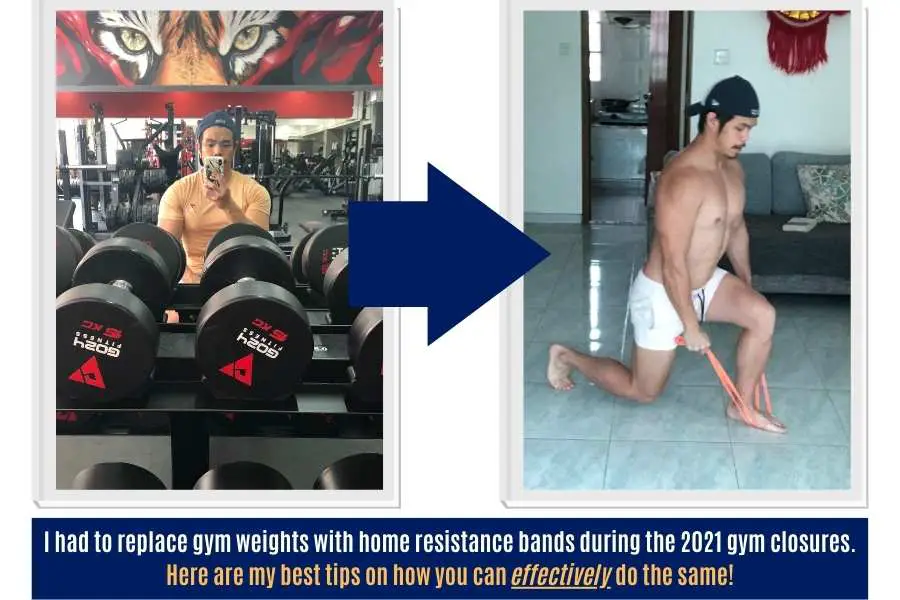
9 Tips To Use Resistance Bands Instead Of Weights
Here are 9 of my best tips to use resistance bands instead of weights to build muscle and lose fat:
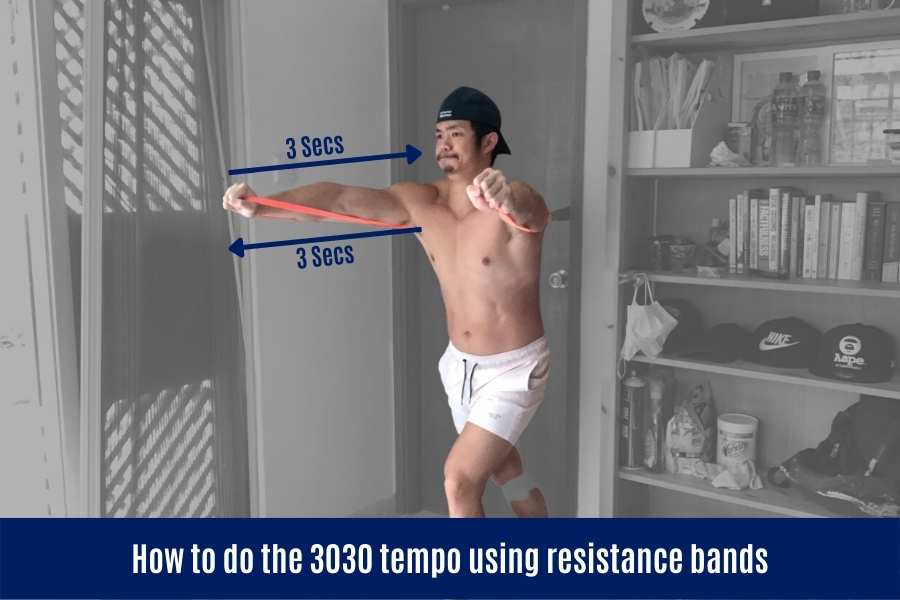
1) Reduce Lifting Tempo When Using Bands
Resistance bands give very little tension in the lower end of an exercise.
Tension only increases as the band stretches towards the upper of an exercise.
This makes it essential to control the tempo of each rep. Doing so allows you to feel each rep as you would with dumbbells and weights. It also promotes maximal muscle activation from that rep.
I found a “3030” tempo to work great for building muscle using resistance bands. This simply means the upward and downward phases of a rep should last 3-seconds each, with a 0-second pause for each transition.
Do not do “bouncing reps”. This is when each rep lasts for less than 1 second and you’re using the elasticity of the band to complete each rep in a “bounce” motion.
This should be avoided at all costs. It’s not good for muscle activation.
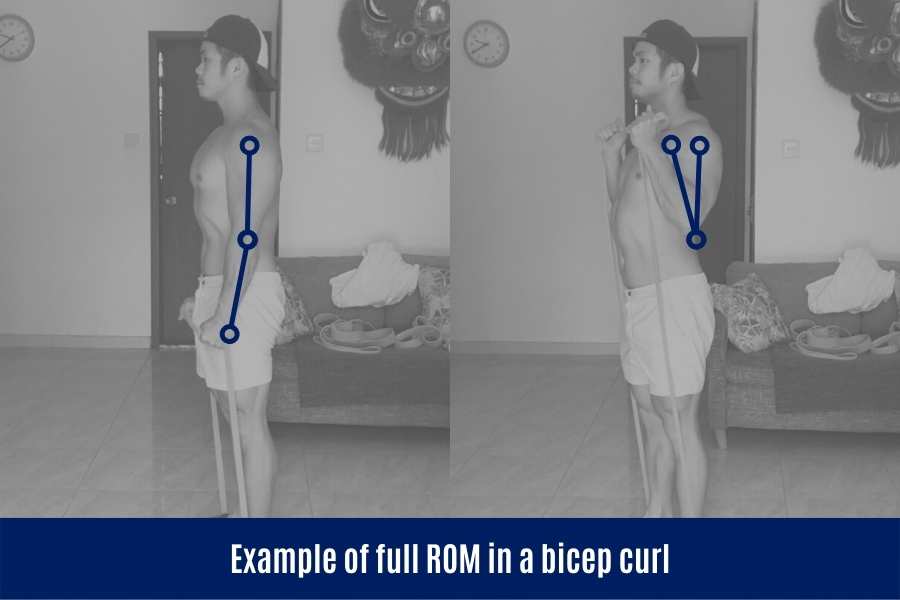
2) Use A Full Range Of Motion With Resistance Bands
Resistance bands can be effectively used instead of weights to build muscle, lose fat, and tone.
But you should be aware of the biggest drawback of using bands; it’s difficult to load them with heavy weights, unlike dumbbells, for example.
I found that using a full range of motion (ROM) in each rep for every rep to be a great way to counter this issue.
Using a full ROM means your joint should move within its maximal range.
In a bicep curl example- the elbow should be fully extended at the bottom of a rep and fully flexed at the top of a rep.
This is much harder than “half reps” or “cheat reps”, but it’s a great way to use your resistance bands to build muscle like weights can.
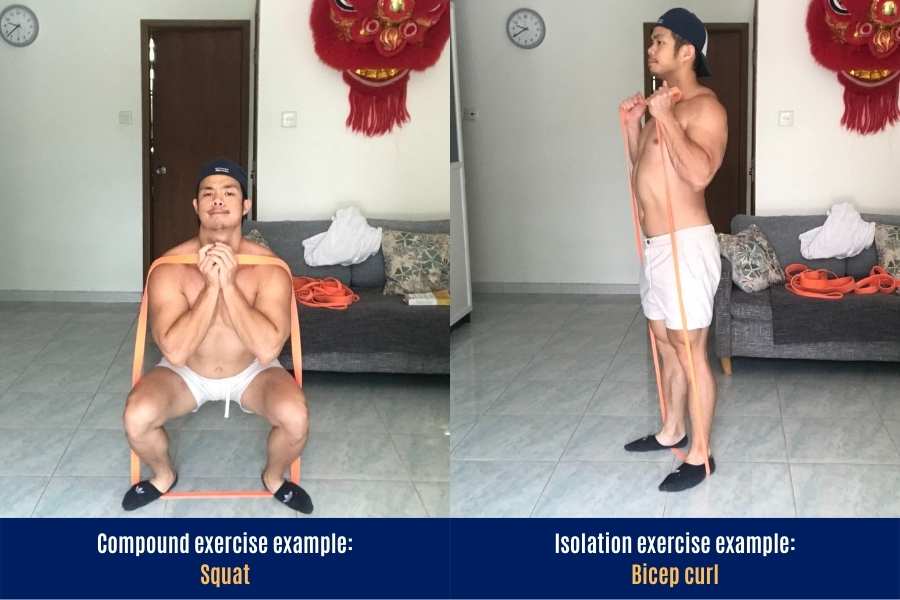
3) Choose Resistance Band Exercises To Do Instead Of Weights
Exercise choice should be carefully chosen just as with weight training.
If you’re looking to build muscle or lose fat, I would recommend focusing on compound movements.
These work multiple muscles at once so they give you the biggest bang for your buck in terms of overall muscle activation and calorie expenditure. Examples include:
- Chest press.
- Banded push-ups.
- Rows.
- Shoulder press.
- Squats.
- Lunges.
- Deadlifts.
If you’re looking to tone and define specific muscles, I would recommend focusing on isolation movements.
These work single muscles so they are great for getting a really good pump on specific body parts. Examples include:
- Bicep curls.
- Tricep extensions.
- Lateral raises.
- Ab crunches.
- Forward/reverse flyes.
- Leg kickbacks/curls.
- Glute bridges.
These resistance band moves can all be used to replace weights.
If you’re interested in learning how to do some of them, you can check out my other article for a list of resistance band exercises for beginners!
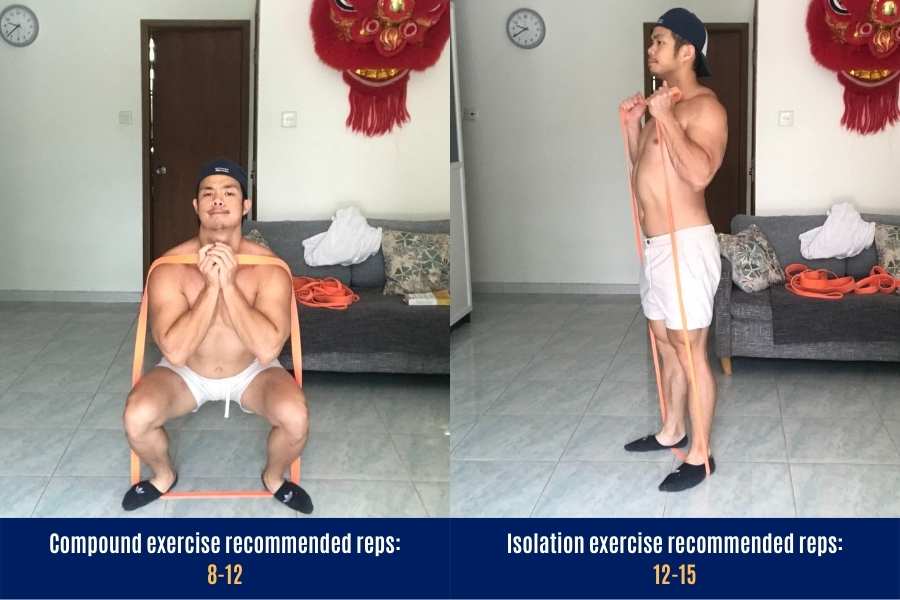
4) Complete 8-15 Reps Per Set
I found that resistance bands can be almost as effective as dumbbells for getting a good muscle pump.
But the best rep range for bands is slightly different than dumbbells (and other free weights).
Most people work in the 6-12 reps per set range with dumbbells. I found 8-15 reps per set to be better with resistance bands.
In other words, higher reps work better for bands (in my opinion).
That’s partly because of the resistance profile of bands; they don’t produce much tension at the start of the exercise and tension only ramps up as the band stretches.
This issue can be countered by increasing reps as recommended.
I like to stay in the 8-12 rep range for compound movements and the 12-15 rep range for isolation movements.
Finally, I recommend completing 3-4 sets per exercise per workout.
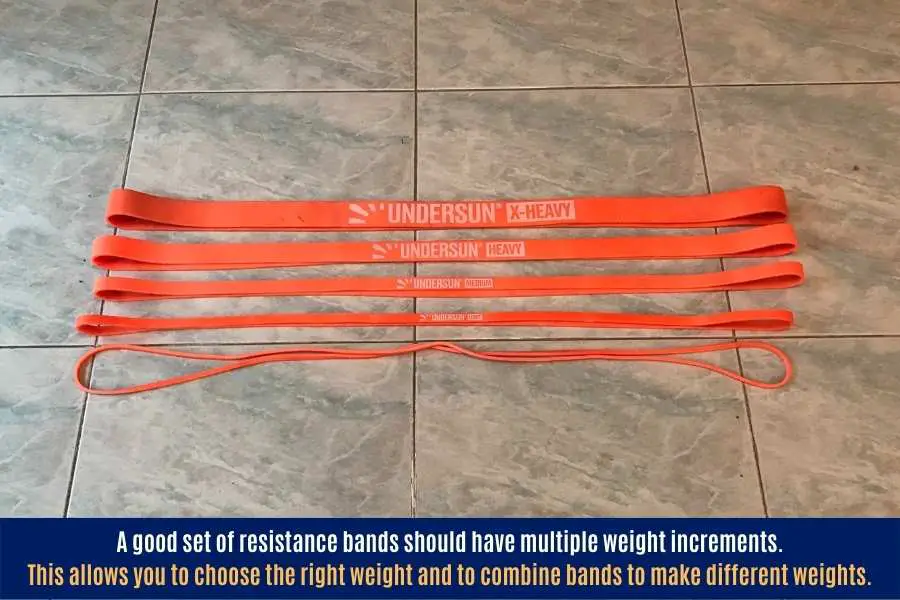
5) Choose A Band Weight That Is Challenging For 8-15 Reps
Just because you’re doing 8-15 reps doesn’t mean you’ll build muscle.
You should also ensure the weight you’re using is challenging and fatiguing your muscles.
As a general rule, you should feel muscular fatigue (aka “the burn”) by the last few reps of each set.
But the band shouldn’t be so heavy that you lose your form or fail to complete your allotted reps.
Play around with your bands to find the ideal weight!
You can also stack different bands and combine them into different weights.
By using the right amount of weight, resistance bands can get you ripped just like weight training can!
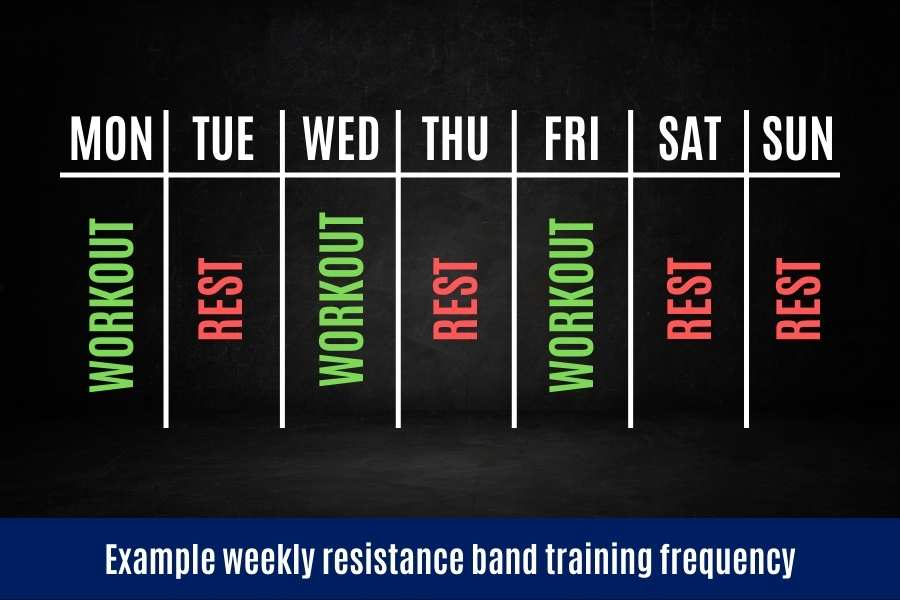
6) Aim For 3-4 Resistance Band Workouts Per Week
As a beginner, you should avoid doing too many resistance band workouts per week.
This can impair muscle recovery and even lead to overtraining.
So if you find yourself having to use your resistance bands every day, something is probably not right…
Aim for 3-4 resistance band workouts per week separated by a full day’s rest between each workout.
Additionally, make sure each of those workouts is performed at a high intensity (i.e. challenging enough to fatigue your muscles).
If exercise intensity is sufficiently high, you shouldn’t have to perform more than 3 workouts per week to build muscle and lose fat.
If you’re interested, you can check out my other post to learn more about how often to use resistance bands.

7) Use Resistance Bands For Up To 1 Hour Per Workout
Extending from the previous point, a workout shouldn’t have to last more than an hour either (if you’re working at a high enough intensity).
One hour is plenty to build muscle and lose fat, both with resistance bands as well as weights.
Most beginners can even see results with 30-minute workouts.
Aim to fit all your allotted reps and sets within a 30-60 minute workout session.
Putting a time limit on your workout like this can help make sure you’re working at a high enough intensity.
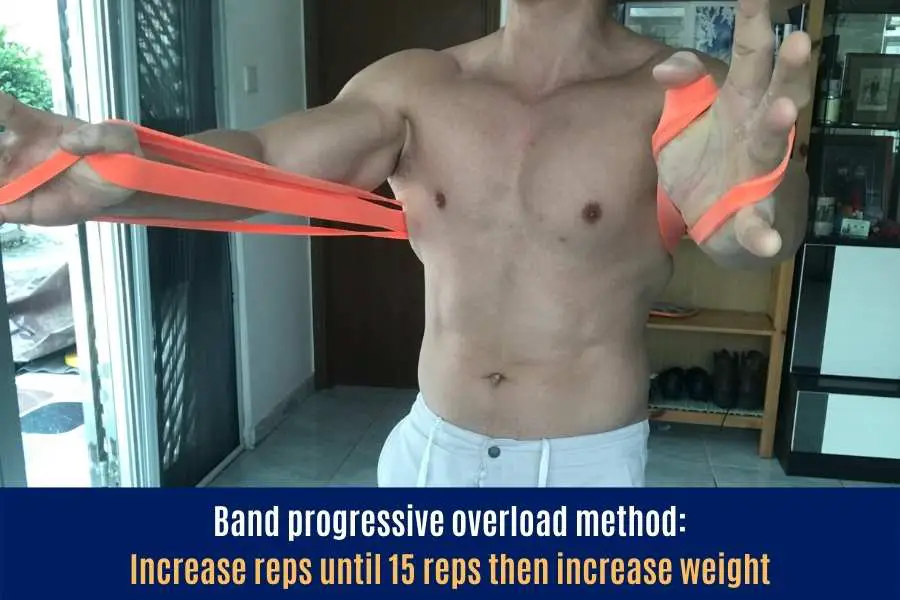
8) Progressive Overload With Reps And Weight
Progressive overload refers to the act of increasing exercise intensity over time. It’s an essential component of building muscle.
Overloading can be done by increasing:
- Weight.
- Reps.
- Sets.
- Workout frequency.
- Decreasing rest times.
Increasing weight is arguably the most popular way for people to progressive overload using dumbbells and weights.
But one of the main disadvantages of bands is that it’s hard to add too much weight too fast, due to their instability and requirement for core strength (you can check out my full list of band pros and cons here).
I found the best way to overload using bands is to first increase reps. And after the 15-rep limit has been reached, you can usually increase band weight.
Here’s an example of how that would look:
- Start with 8 reps per set using a 20lb light band.
- Slowly work to 15 reps per set using the 20lb light band.
- Swap to a 50lb medium band once 15 reps per set becomes easy.
- Reduce to 8 reps per set using the 50lb medium band.
This allows you to overload on weight quite smoothly since increasing reps will build your muscular strength.
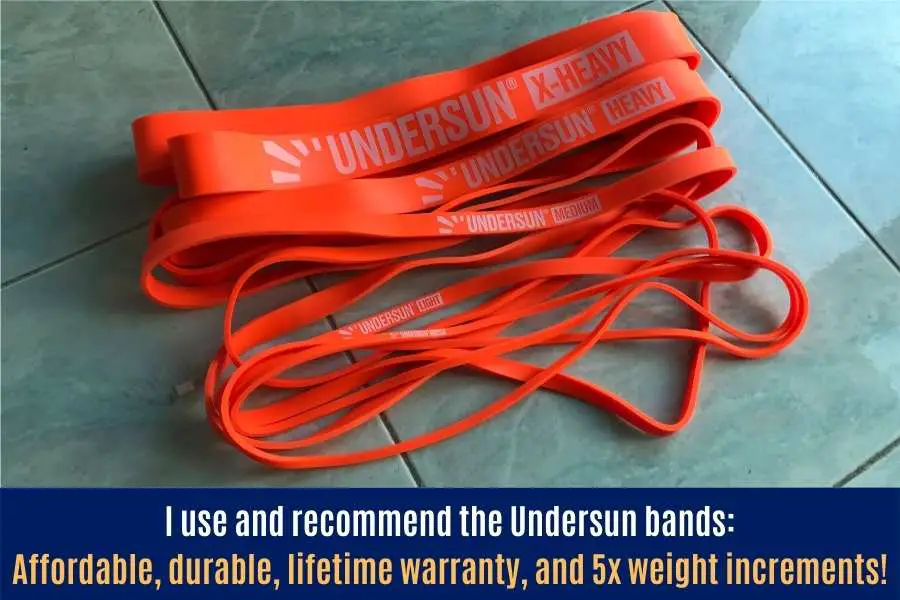
9) Get A Good Set Of Resistance Bands
If you want to use resistance bands instead of weights to build muscle and lose fat, you better get a good set of bands.
That’s plural not singular by the way.
Whilst a single band can be good for casual workouts, it’s not enough if you’re serious about building muscle.
Why?
Different muscles have different strengths and therefore are more suited to different band weights.
Additionally, you’ll need to increase band weight at some point to continue building muscle (i.e. progressive overload).
Having a good set of bands with different weights and colors at your disposal will allow you to do this.
Recommended Resistance Bands To Replace Weights
A good set of circular loop bands from a reputable company is one of the most cost-effective ways to train without weights.
I’ve had a very pleasant experience with my Undersun bands.
They come in a variety of tension levels.
This makes them suitable for all training levels and to target small and large muscles alike!
They’re also extremely durable.
Conclusion
I’ve shared 9 tips on how to use resistance bands instead of weights.
Applying these tips to your resistance band workouts can help you build more muscle and lose more fat!
These tips helped me get the most out of my resistance bands, and I hope they can help you do the same!
Are there any other tips you can think of to replace weights with bands?
Feel free to send me a message if you have any questions! You can find my details on the “contact us” page.
You may also be interested in the downloadable Kalibre Blueprint PDF which details exactly how I gained 40lbs of lean muscle (it’s 100% free!). It details the exact exercises and nutrition (with printable worksheets) I used to go from skinny to ripped!
Thanks for reading guys!
Peace Out,
Kal
(Biochemistry BSc, Biomedical Sciences MSc, Ex-Skinny Guy)


